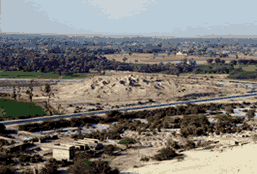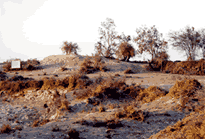| |

 Kot Diji Kot Diji
The site of Kot Diji is located at the foot of a range of limestone hills in northern Sind on the eastern bank of the Indus River, some 60 kilometers northeast of Mohenjo daro. Excavated in 1955 by F. A. Khan, it is the type-site of Kot Diji Culture, which represents the first evidence of habitation at the site. This culture is characterized by the use of the red-slipped globular jar with a short neck painted with a black band. Briefly coexisting with the Indus Civilization (the Harappan Culture), the Kot Diji Culture eventually gave way to the blossoming Indus Civilization.
During the peak of the Kot Diji Culture, the site was divided into a "Citadel" and a "Lower Town".
Standardized bricks, terracotta cakes, fish-scale and intersecting-circle designs on pottery and other traits found in the Indus Civilization were already in use at the site. On the basis of this evidence and the fact that similar artifacts were found over much of the vast area of the later Indus (or Harappan) Civilization, Dr. M. R. Mughal suggested calling this early stage at Kot Diji and at other sites the "Early Harappan Culture".
|
| |

 Amri Amri
Amri is also located in Sind (Pakistan) on the western bank of the Indus River, approximately 150 kilometers south of Mohenjo daro. The site was excavated by N. G. Majumdar in 1929 and by J.-M. Casal between 1959 and 1962. The site reached its maximum extent of over six hectares under the influence of the Balochistan Culture. A number of structures identified as granaries were constructed, which suggests that there were farm surpluses and population growth. Pottery from the early period at this site is similar to the Nal pottery of southern Balochistan and is thus sometimes referred to as "Amri-Nal" pottery.
During the transitional phase with the Harappan Culture (or Indus Civilization), a wall encircled the site and a platform made of sun-dried bricks was constructed inside. A thick layer of ash over parts of the site suggests an incident with fire, after which the site exhibits the exclusive influence of the Harappan Culture.
|



